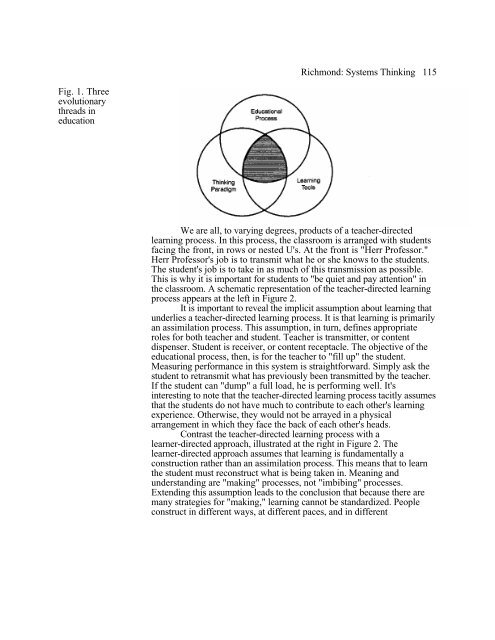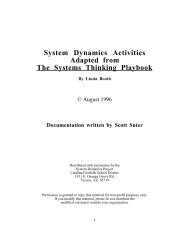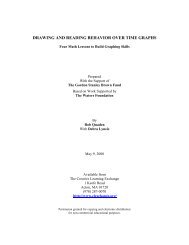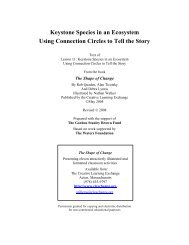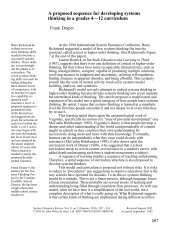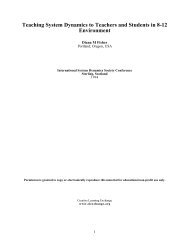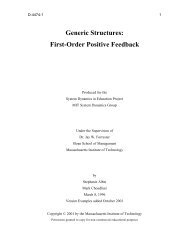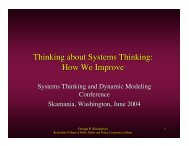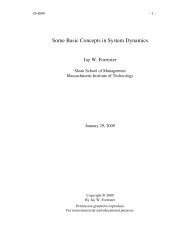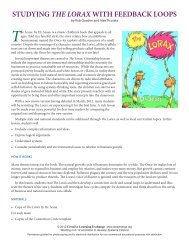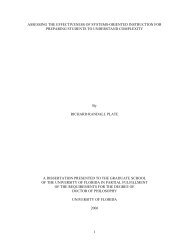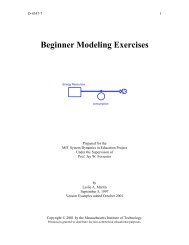114 System Dynamics Review Volume 9 Number 2 Summer 1993light on what wehave to bestow <strong>and</strong>on <strong>the</strong> educationsystem that is toreceive our bounty.Its intended audienceis both systemthinkers <strong>and</strong>educators, <strong>and</strong> <strong>the</strong>hope is to helperadicate <strong>the</strong>distinction between<strong>the</strong> two.Barry Richmond ismanaging director<strong>and</strong> founder of HighPer<strong>for</strong>mance <strong>Systems</strong>,an organizationproviding software<strong>and</strong> consultingservices to build <strong>the</strong>capacity of people tounderst<strong>and</strong> <strong>and</strong> improve<strong>the</strong> workingsof dynamic systems.Dr. Richmond is <strong>the</strong>impetus behind <strong>the</strong>iThink <strong>and</strong> STELLAII modeling <strong>and</strong>simulation softwarepackages. He hastaught at ThayerSchool of Engineering,Dartmouth College,<strong>and</strong> holds a Ph.D. degree in systemdynamics from SloanSchool ofManagement, MIT,<strong>and</strong> degrees fromSyracuse, Columbia,<strong>and</strong> Case WesternReserve universities.Address: High Per<strong>for</strong>mance<strong>Systems</strong>,45 Lyme Rd.,Hanover, NH 03755,U.S.A.realities." In <strong>the</strong>se electronic realities, people will be able to participate increating powerful, visceral experiences <strong>for</strong> <strong>the</strong>mselves. But, no matterhow advanced <strong>the</strong> technology gets, it will always be only part of <strong>the</strong>solution. If people are to make sense of <strong>the</strong>ir experiences in virtualrealities, <strong>the</strong>y must have <strong>the</strong> capacity <strong>for</strong> underst<strong>and</strong>ing <strong>the</strong> underlyingclosed-loop framework that is generating <strong>the</strong>se experiences. They mustbe capable of <strong>thinking</strong> both systemically <strong>and</strong> dynamically. In short, <strong>the</strong>ymust be systems thinkers. This, in turn, brings us back to along-unanswered question, which has plagued system dynamics from itsoutset some 30 years ago at that venerable technical university on <strong>the</strong>Charles River in Cambridge, Massachusetts. The question is, How can<strong>the</strong> framework, <strong>the</strong> process, <strong>and</strong> <strong>the</strong> technologies of systems <strong>thinking</strong> betransferred to <strong>the</strong> rest of <strong>the</strong> world in an amount of time that isconsiderably less than what it currently takes to get a master's or Ph.D.degree in our field?I will argue that to successfully answer this question it isnecessary to confront two aspects of <strong>the</strong> transfer process. We first mustbetter underst<strong>and</strong> <strong>the</strong> evolution of <strong>the</strong> education system into which <strong>the</strong>transfer must be made (this system offers <strong>the</strong> best potential <strong>for</strong>large-scale transfer). Second, we must better underst<strong>and</strong> <strong>the</strong> "thing" weare seeking to transfer. Specifically, we must underst<strong>and</strong> that this "thing"is multifaceted. As such, <strong>for</strong> people to swallow <strong>and</strong> digest it, it must bebroken down into more consumable pieces.Aspect 1: <strong>the</strong> evolution of <strong>the</strong> education systemLike any viable system, our system of <strong>for</strong>mal education isevolving over time. The last several decades have seen numerousinnovative experiments in educational progress <strong>and</strong> technology. Openclassrooms, computer-aided instruction, <strong>and</strong> interdisciplinary courseofferings are but a few of <strong>the</strong> initiatives that have been <strong>and</strong> are beingtried. It is my perception that <strong>the</strong> time is now ripe <strong>for</strong> three evolutionarythreads to come toge<strong>the</strong>r to <strong>for</strong>m a new learning gestalt. The threethreads, illustrated in Figure 1, are educational process, <strong>thinking</strong>paradigm, <strong>and</strong> learning tools. The evolutionary fusing of <strong>the</strong>se threethreads can successfully create a permanent change in <strong>the</strong> way peoplelearn. The evolution of each thread, taken independently, cannot.Thread 1: educational processI will refer to <strong>the</strong> newly emerging educational process as learnerdirectedlearning. I like this phrase because it positions <strong>the</strong> process insharp relief against <strong>the</strong> process that has dominated teaching <strong>for</strong> at least<strong>the</strong> last 200 years: teacher-directed learning.
Richmond: <strong>Systems</strong> Thinking 115Fig. 1. Threeevolutionarythreads ineducationWe are all, to varying degrees, products of a teacher-directedlearning process. In this process, <strong>the</strong> classroom is arranged with studentsfacing <strong>the</strong> front, in rows or nested U's. At <strong>the</strong> front is "Herr Professor."Herr Professor's job is to transmit what he or she knows to <strong>the</strong> students.The student's job is to take in as much of this transmission as possible.This is why it is important <strong>for</strong> students to "be quiet <strong>and</strong> pay attention" in<strong>the</strong> classroom. A schematic representation of <strong>the</strong> teacher-directed learningprocess appears at <strong>the</strong> left in Figure 2.It is important to reveal <strong>the</strong> implicit assumption about learning thatunderlies a teacher-directed learning process. It is that learning is primarilyan assimilation process. This assumption, in turn, defines appropriateroles <strong>for</strong> both teacher <strong>and</strong> student. Teacher is transmitter, or contentdispenser. Student is receiver, or content receptacle. The objective of <strong>the</strong>educational process, <strong>the</strong>n, is <strong>for</strong> <strong>the</strong> teacher to "fill up" <strong>the</strong> student.Measuring per<strong>for</strong>mance in this system is straight<strong>for</strong>ward. Simply ask <strong>the</strong>student to retransmit what has previously been transmitted by <strong>the</strong> teacher.If <strong>the</strong> student can "dump" a full load, he is per<strong>for</strong>ming well. It'sinteresting to note that <strong>the</strong> teacher-directed learning process tacitly assumesthat <strong>the</strong> students do not have much to contribute to each o<strong>the</strong>r's learningexperience. O<strong>the</strong>rwise, <strong>the</strong>y would not be arrayed in a physicalarrangement in which <strong>the</strong>y face <strong>the</strong> back of each o<strong>the</strong>r's heads.Contrast <strong>the</strong> teacher-directed learning process with alearner-directed approach, illustrated at <strong>the</strong> right in Figure 2. Thelearner-directed approach assumes that learning is fundamentally aconstruction ra<strong>the</strong>r than an assimilation process. This means that to learn<strong>the</strong> student must reconstruct what is being taken in. Meaning <strong>and</strong>underst<strong>and</strong>ing are "making" processes, not "imbibing" processes.Extending this assumption leads to <strong>the</strong> conclusion that because <strong>the</strong>re aremany strategies <strong>for</strong> "making," learning cannot be st<strong>and</strong>ardized. Peopleconstruct in different ways, at different paces, <strong>and</strong> in different


